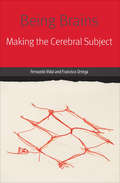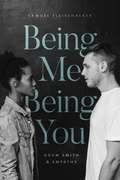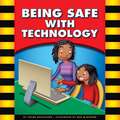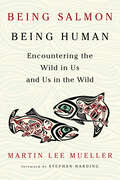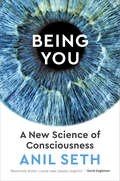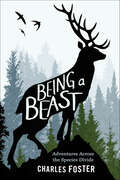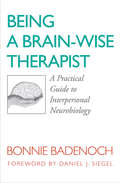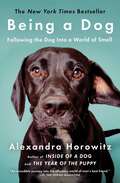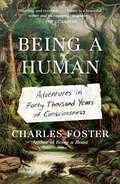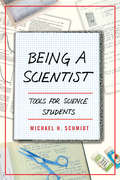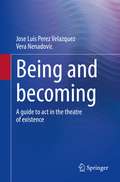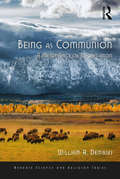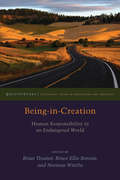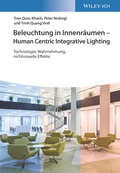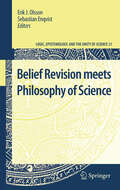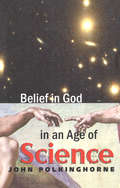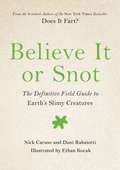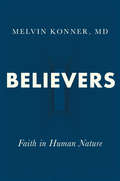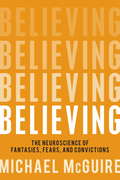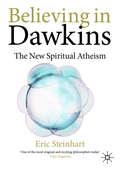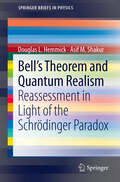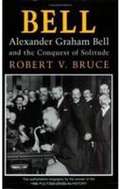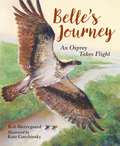- Table View
- List View
Being Brains: Making the Cerebral Subject (Forms Of Living Ser.)
by Fernando Vidal Francisco OrtegaThis &“interesting, informative, and provocative book&” explores the pervasive influence of neuroscience and &“the view that we are essentially our brains&” (History and Philosophy of the Life Sciences). Being Brains offers a critical exploration of neurocentrism, the belief that &“we are our brains,&” which came to prominence in the 1990s. Encouraged by advances in neuroimaging, the humanities and social sciences have gravitated toward the brain as well, developing neuro-subspecialties in fields such as anthropology, aesthetics, education, history, law, sociology, and theology. Even in the business world, dubious enterprises such as &“neuromarketing&” and &“neurobics&” have emerged to take advantage of the heightened sensitivity to all things neuro. While neither hegemonic nor monolithic, the neurocentric view embodies a powerful ideology that is at the heart of some of today&’s most important philosophical, ethical, scientific, and political debates. Being Brains examines the internal logic of this new ideology, as well as its genealogy and its main contemporary incarnations. Being Brains was chosen as the 2018 Outstanding Book in the History of the Neurosciences by the International Society for the History of the Neurosciences.
Being Me Being You: Adam Smith & Empathy
by Samuel FleischackerModern notions of empathy often celebrate its ability to bridge divides, to unite humankind. But how do we square this with the popular view that we can never truly comprehend the experience of being someone else? In this book, Samuel Fleischacker delves into the work of Adam Smith to draw out an understanding of empathy that respects both personal difference and shared humanity. After laying out a range of meanings for the concept of empathy, Fleischacker proposes that what Smith called “sympathy” is very much what we today consider empathy. Smith’s version has remarkable value, as his empathy calls for entering into the perspective of another—a uniquely human feat that connects people while still allowing them to define their own distinctive standpoints. After discussing Smith’s views in relation to more recent empirical and philosophical studies, Fleischacker shows how turning back to Smith promises to enrich, clarify, and advance our current debates about the meaning and uses of empathy.
Being Safe with Technology
by Susan KesselringThis fun, colorful book describes basic rules for what to do and what not to do to be safe on your phone and online. Other books in this series are available in this library.
Being Salmon, Being Human: Encountering the Wild in Us and Us in the Wild
by Martin Lee MuellerNautilus Award Silver Medal Winner, Ecology & Environment In search of a new story for our place on earthBeing Salmon, Being Human examines Western culture&’s tragic alienation from nature by focusing on the relationship between people and salmon―weaving together key narratives about the Norwegian salmon industry as well as wild salmon in indigenous cultures of the Pacific Northwest.Mueller uses this lens to articulate a comprehensive critique of human exceptionalism, directly challenging the four-hundred-year-old notion that other animals are nothing but complicated machines without rich inner lives and that Earth is a passive backdrop to human experience. Being fully human, he argues, means experiencing the intersection of our horizon of understanding with that of other animals. Salmon are the test case for this. Mueller experiments, in evocative narrative passages, with imagining the world as a salmon might see it, and considering how this enriches our understanding of humanity in the process.Being Salmon, Being Human is both a philosophical and a narrative work, rewarding readers with insightful interpretations of major philosophers―Descartes, Heidegger, Abram, and many more―and reflections on the human–Earth relationship. It stands alongside Abram&’s Spell of the Sensuous and Becoming Animal, as well as Andreas Weber&’s The Biology of Wonder and Matter and Desire―heralding a new &“Copernican revolution&” in the fields of biology, ecology, and philosophy.&“Philosophically, scientifically, morally, and artistically, Mueller blows the [salmon] industry guys literally out of the water. If you care about the future of salmon, you must read this essential, rigorously documented book.&”―Sy Montgomery, coauthor of Tamed and Untamed; author of The Soul of an Octopus&“A marvelous exploration of what it means to belong within life&’s community. Mueller integrates imagination and analysis to produce a book of rare and important insight.&”―David George Haskell, author of The Songs of Trees
Being With Animals: Why We Are Obsessed with the Furry, Scaly, Feathered Creatures Who Populate Our World
by Barbara J. KingWhat do Mickey Mouse, Ganesh, a leopard-skin pillbox hat,A Lion Called Christian, and the Aflac duck have in common? They all represent human beings' deeply ingrained connection to the animal kingdom. InBeing With Animals,anthropologist Barbara King unravels the complexity and enormous significance of this relationship. Animals rule our existence. You can see this in the billions of dollars Americans pour out each year for their pets, in the success of books and films such asMarley and Me,in th...
Being You: A New Science of Consciousness
by Anil SethINTERNATIONAL BESTSELLER"A brilliant beast of a book."—David Byrne"Exhilarating... a vast-ranging, phenomenal achievement that will undoubtedly become a seminal text." —The GuardianAnil Seth's quest to understand the biological basis of conscious experience is one of the most exciting contributions to twenty-first-century science.What does it mean to &“be you&”—that is, to have a specific, conscious experience of the world around you and yourself within it? There may be no more elusive or fascinating question. Historically, humanity has considered the nature of consciousness to be a primarily spiritual or philosophical inquiry, but scientific research is now mapping out compelling biological theories and explanations for consciousness and selfhood. Now, internationally renowned neuroscience professor, researcher, and author Anil Seth is offers a window into our consciousness in BEING YOU: A New Science of Consciousness. Anil Seth is both a leading expert on the neuroscience of consciousness and one of most prominent spokespeople for this relatively new field of science. His radical argument is that we do not perceive the world as it objectively is, but rather that we are prediction machines, constantly inventing our world and correcting our mistakes by the microsecond, and that we can now observe the biological mechanisms in the brain that accomplish this process of consciousness.Seth has been interviewed for documentaries aired on the BBC, Netflix, and Amazon and podcasts by Sam Harris, Russell Brand, and Chris Anderson, and his 2017 TED Talk on the topic has been viewed over 11 million times, a testament to his uncanny ability to make unimaginably complex science accessible and entertaining.
Being a Beast: Adventures Across the Species Divide
by Charles FosterA passionate naturalist explores what it’s really like to be an animal—by living like themHow can we ever be sure that we really know the other? To test the limits of our ability to inhabit lives that are not our own, Charles Foster set out to know the ultimate other: the non-humans, the beasts. And to do that, he tried to be like them, choosing a badger, an otter, a fox, a deer, and a swift. He lived alongside badgers for weeks, sleeping in a sett in a Welsh hillside and eating earthworms, learning to sense the landscape through his nose rather than his eyes. He caught fish in his teeth while swimming like an otter; rooted through London garbage cans as an urban fox; was hunted by bloodhounds as a red deer, nearly dying in the snow. And he followed the swifts on their migration route over the Strait of Gibraltar, discovering himself to be strangely connected to the birds. A lyrical, intimate, and completely radical look at the life of animals—human and other—Being a Beast mingles neuroscience and psychology, nature writing and memoir to cross the boundaries separating the species. It is an extraordinary journey full of thrills and surprises, humor and joy. And, ultimately, it is an inquiry into the human experience in our world, carried out by exploring the full range of the life around us.
Being a Brain-Wise Therapist: A Practical Guide to Interpersonal Neurobiology (Norton Series on Interpersonal Neurobiology)
by Bonnie BadenochThis book, part of the acclaimed Norton Series on Interpersonal Neurobiology, brings interpersonal neurobiology into the counseling room, weaving the concepts of neurobiology into the ever-changing flow of therapy. Neuroscientific discoveries have begun to illuminate the workings of the active brain in intricate detail. In fact, sometimes it seems that in order to be a cutting-edge therapist, not only do you need knowledge of traditional psychotherapeutic models, but a solid understanding of the role the brain plays as well. But theory is never enough. You also need to know how to apply the theories to work with actual clients during sessions. In easy-to-understand prose, Being a Brain-Wise Therapist reviews the basic principles about brain structure, function, and development, and explains the neurobiological correlates of some familiar diagnostic categories. You will learn how to make theory come to life in the midst of clinical work, so that the principles of interpersonal neurobiology can be applied to a range of patients and issues, such as couples, teens, and children, and those dealing with depression, anxiety, and other disorders. Liberal use of exercises and case histories enliven the material and make this an essential guide for seamlessly integrating the latest neuroscientific research into your therapeutic practice.
Being a Dog: Following the Dog Into a World of Smell
by Alexandra HorowitzFrom the #1 bestselling author of Inside of a Dog and The Year of the Puppy—&“an incredible journey into the olfactory world of man&’s best friend&” (O, The Oprah Magazine), Alexandra Horowitz&’s follow-up to her New York Times bestseller explains how dogs experience the world through their most spectacular organ—the nose.In her &“fascinating book…Horowitz combines the expertise of a scientist with an easy, lively writing style&” (The New York Times Book Review) as she imagines what it is like to be a dog. Guided by her own dogs, Finnegan and Upton, Horowitz sets off on a quest through the cutting-edge science behind the olfactory abilities of the dog. In addition to speaking to cognitive researchers and smell experts, Horowitz visits detection-dog trainers and training centers; she meets researchers working with dogs to detect cancerous cells and anticipate epileptic seizure or diabetic shock; and she even attempts to smell-train her own nose. As we come to understand how rich, complex, and exciting the world around us is to the canine nose, Horowitz changes our perspective on dogs forever. Readers will finish this book feeling that they have broken free of their human constraints and understanding smell as never before; that they have, for however fleetingly, been a dog. And, as The Boston Globe says about Being a Dog, &“becoming more doglike, not surprisingly, can make anyone&’s life a little more vivid.&”
Being a Human: Adventures in Forty Thousand Years of Consciousness
by Charles FosterNAMED A BEST BOOK OF THE YEAR BY THE ATLANTIC, KIRKUS REVIEWS, AND NEW STATESMAN A radically immersive exploration of three pivotal moments in the evolution of human consciousness, asking what kinds of creatures humans were, are, and might yet beHow did humans come to be who we are? In his marvelous, eccentric, and widely lauded book Being a Beast, legal scholar, veterinary surgeon, and naturalist extraordinaire Charles Foster set out to understand the consciousness of animal species by living as a badger, otter, fox, deer, and swift. Now, he inhabits three crucial periods of human development to understand the consciousness of perhaps the strangest animal of all—the human being.To experience the Upper Paleolithic era—a turning point when humans became behaviorally modern, painting caves and telling stories, Foster learns what it feels like to be a Cro-Magnon hunter-gatherer by living in makeshift shelters without amenities in the rural woods of England. He tests his five impoverished senses to forage for berries and roadkill and he undertakes shamanic journeys to explore the connection of wakeful dreaming to religion. For the Neolithic period, when humans stayed in one place and domesticated plants and animals, forever altering our connection to the natural world, he moves to a reconstructed Neolithic settlement. Finally, to explore the Enlightenment—the age of reason and the end of the soul—Foster inspects Oxford colleges, dissecting rooms, cafes, and art galleries. He finds his world and himself bizarre and disembodied, and he rues the atrophy of our senses, the cause for much of what ails us.Drawing on psychology, neuroscience, natural history, agriculture, medical law and ethics, Being a Human is one man’s audacious attempt to feel a connection with 45,000 years of human history. This glorious, fiercely imaginative journey from our origins to a possible future ultimately shows how we might best live on earth—and thrive.
Being a Scientist: Tools for Science Students (G - Reference, Information And Interdisciplinary Subjects Ser.)
by Michael H. SchmidtBeing a Scientist is a comprehensive introduction to the many aspects of scientific life beyond the classroom and laboratory. Written with undergraduate science majors in mind, the book covers ethics, the philosophical bases of scientific methods, library research, reading, peer review, creativity, proposal and paper writing, and oral and poster presentations. In contrast to other texts in the field, which often take a simple prescriptive approach to these topics, Being a Scientist connects them to the historical and philosophical roots of modern science, as well as the common experiences of all people. Written in a conversational style, the book makes use of metaphor, historical anecdote, and hypothetical research about everyday household questions. This approach helps undergraduates learn basic research skills without being too intimidated by the advanced concepts, vocabulary, and methods which are encountered in looking at the current scientific literature. Being a Scientist is a textbook for a semester-long course devoted to teaching research and communication skills to undergraduate science majors, but it can be adapted for use in summer research experiences, capstone research courses, and other courses throughout the undergraduate curriculum.
Being and becoming: A guide to act in the theatre of existence
by Jose Luis Perez Velazquez Vera NenadovicMany people spend considerable time seeking a sense of purpose in life and, concomitant with that, a sense of personal identity. This book demystifies this search, revealing why this search is a fallacy. The purpose is to inform readers about results in neuroscience and biophysics that may guide us to some liberation needed in the current age of great complexity in life with a diverse burden of chores; a deliverance from some afflictions that prevent individuals from achieving the true purpose of our lives. Among these afflictions we find two primordial concerns: the belief and subsequent attachment to a self, and the conviction that life must have a deep purpose in which we are major players. While this is a scientific text, it can easily be read by a lay audience, written with minimal technical jargon and with references to scientific papers enough to satisfy the curious. We have tried to extract the essence of scientific observations such that we can glimpse at those aforementioned concerns about the self and life, observations which help us comprehend what we are and what we become, the being and becoming of our own selves and natural phenomena around us. Jose Luis Perez Velazquez received a PhD in Molecular Physiology & Biophysics. His research seeks principles of biological organisation. He worked at the Hospital for Sick Children in Toronto and was Professor at the University of Toronto. Currently he is a Research Scholar at the Ronin Institute and lives in the natural paradise of Asturias, in Northern Spain. Vera Nenadovic is a nurse practitioner, neuroscientist and entrepreneur. She has 30 years of experience in healthcare from First Nations communities to intensive care units. Her research focuses on predicting brain injury outcomes. She is a clinician and researcher at Holland Bloorview Kids Rehab Hospital. Her startup company BrainsView is commercializing software that analyzes brainwaves to monitor brain function and recovery after head injury. She is married and lives in Toronto, with her husband and Rottweiler.
Being as Communion: A Metaphysics of Information (Routledge Science and Religion Series)
by William A. DembskiFor a thing to be real, it must be able to communicate with other things. If this is so, then the problem of being receives a straightforward resolution: to be is to be in communion. So the fundamental science, indeed the science that needs to underwrite all other sciences, is a theory of communication. Within such a theory of communication the proper object of study becomes not isolated particles but the information that passes between entities. In Being as Communion philosopher and mathematician William Dembski provides a non-technical overview of his work on information. Dembski attempts to make good on the promise of John Wheeler, Paul Davies, and others that information is poised to replace matter as the primary stuff of reality. With profound implications for theology and metaphysics, Being as Communion develops a relational ontology that is at once congenial to science and open to teleology in nature. All those interested in the intersections of theology, philosophy and science should read this book.
Being the Person Your Dog Thinks You Are: The Science of a Better You
by Jim DaviesA crisp and sparkling blend of cognitive science and human behavior that offers meaningful and attainable pathways towards becoming our best selves. Why do we feel like in order to be productive, happy, or good, we must sacrifice everything else? Is it possible to feel all three at once? Without even knowing it, we&’re doing things everyday to sabotage ourselves and our societies, habits that prevent us from optimizing long term happiness. Where most books imagine solutions that, when enacted, fail to fundamentally improve our lives, Jim Davies grounds his research in cognitive science to show you not only what works, but how much it works. Being the Person Your Dog Thinks You Are shows us how we can use science to become our best selves, using resources we already have within our own brains. Davies's book challenges and inspires us to approach the big picture while also staying mindful of the everyday details in real life. Davies proves why multitasking is bad for you, when a little unmindfulness can be good for you, how to best justify which charities to donate to, and how to hack your brain. The most surprising truth Davies offers us spreads across these pages like wildfire: you too can lead an optimally good life, not through uprooting your life from the ground up, but from adapting your mentality to your given present. A better life doesn&’t need to look like a massive change—like our beloved dogs who already view us as our best selves, it&’s already much closer than you think.
Being-in-Creation: Human Responsibility in an Endangered World (Groundworks: Ecological Issues in Philosophy and Theology)
by Bruce Ellis Benson Norman WirzbaWhat is the proper relationship between human beings and the more-than-human world? This philosophical question, which underlies vast environmental crises, forces us to investigate the tension between our extraordinary powers, which seem to set us apart from nature, even above it, and our thoroughgoing ordinariness, as revealed by the evolutionary history we share with all life.The contributors to this volume ask us to consider whether the anxiety of unheimlichkeit, which in one form or another absorbed so much of twentieth-century philosophy, might reveal not our homelessness in the cosmos but a need for a fundamental belongingness and implacement in it.
Beleuchtung in Innenräumen - Human Centric Integrative Lighting: Technologie, Wahrnehmung, nichtvisuelle Effekte
by Tran Quoc Khanh Peter Bodrogi Trinh Quang VinhAusführliche Darstellung der technischen und nicht-technischen Aspekte der modernen Beleuchtungstechnik im Blick auf die Wirkung auf den Menschen! Die moderne Lichttechnik befasst sich nicht nur mit den technischen Aspekten von Beleuchtung in Innenräumen, sondern auch mit der Wirkung unterschiedlicher Arten von Beleuchtung auf den Menschen. Über die genaue Kenntnis der physikalischen Eigenschaften von Licht und der Lichterzeugung hinaus werden dazu validierte physiologische und psychologische Wahrnehmungsmodelle benötigt, auf deren Basis Hersteller von Leuchtmitteln und Anbieter von Lichttechniklösungen Design- und Entwicklungsentscheidungen treffen können. Dieses Buch gibt einen Überblick über das Forschungsgebiet des Human Centric Integrative Lighting, also der menschzentrierten Innenraumbeleuchtungstechnik. Nach einer Zusammenfassung der Grundlagen der Lichttechnik im Zusammenspiel mit der menschlichen Wahrnehmung und dem aktuellen Stand der heutigen Innenraumbeleuchtung legen die Autoren die Grundprinzipien des Human Centric Integrative Lighting dar und schildern ausführlich Aspekte wie visuelle Leistungen, Farbqualität und emotionale Wirkung sowie die Korrelation der relevanten Parameter. Im Anschluss diskutieren sie umfassende Lichtqualitätsmodelle und leiten daraus Empfehlungen für die praktische Umsetzung des Konzepts des Human Centric Integrative Lighting ab. * Geballtes Expertenwissen: das Buch ist geschrieben von Deutschlands führenden Wissenschaftlern auf dem Gebiet der Lichttechnik * Kohärente Zusammenfassung des Forschungsstands: das Buch kombiniert die relevanten Forschungsergebnisse aus Zeitschriften, Patentschriften und Normen zu einem einheitlichen Ganzen * Praxisorientierter Ansatz: die wissenschaftlichen Erkenntnisse werden zu Modellen kondensiert, die für Entwickler direkt nutzbar sind
Belief Revision meets Philosophy of Science (Logic, Epistemology, and the Unity of Science #21)
by Sebastian Enqvist Erik J OlssonBelief revision theory and philosophy of science both aspire to shed light on the dynamics of knowledge - on how our view of the world changes (typically) in the light of new evidence. Yet these two areas of research have long seemed strangely detached from each other, as witnessed by the small number of cross-references and researchers working in both domains. One may speculate as to what has brought about this surprising, and perhaps unfortunate, state of affairs. One factor may be that while belief revision theory has traditionally been pursued in a bottom- up manner, focusing on the endeavors of single inquirers, philosophers of science, inspired by logical empiricism, have tended to be more interested in science as a multi-agent or agent-independent phenomenon.
Belief in God in an Age of Science
by John PolkinghorneJohn Polkinghorne is a major figure in today's debates over the compatibility of science and religion. Internationally known as both a theoretical physicist and a theologian-the only ordained member of the Royal Society-Polkinghorne brings unique qualifications to his inquiry into the possibilities of believing in God in an age of science. In this thought-provoking book, the author focuses on the collegiality between science and theology, contending that these "intellectual cousins" are both concerned with interpreted experience and with the quest for truth about reality. He argues eloquently that scientific and theological inquiries are parallel.The book begins with a discussion of what belief in God can mean in our times. Polkinghorne explores a new natural theology and emphasizes the importance of moral and aesthetic experience and the human intuition of value and hope. In other chapters, he compares science's struggle to understand the nature of light with Christian theology's struggle to understand the nature of Christ. He addresses the question, Does God act in the physical world? And he extends his ideas about the role of chaos theory, surveys the prospects for future dialogue between scientific and theological thinkers, and defends a critical realist understanding of the activities of both disciplines. Polkinghorne concludes with a consideration of the nature of mathematical truths and the links between the complementary realities of physical and mental experience.
Believe It or Snot: The Definitive Field Guide to Earth's Slimy Creatures (Does It Fart Series #3)
by Nick Caruso Dani RabaiottiFrom the scientist duo behind the New York Times bestselling sensation Does It Fart? and their excremental follow up True or Poo?, Believe It Or Snot explores the myriad variety of slime in the animal and plant kingdoms.Your little brother isn't the only nose-picking animal.What is hyena butter and would it be appropriate to spread on toast? Why is giraffe saliva such a good lubricant? How does some mollusk mucus work like a fishing pole? And what's the deal with pygmy sperm whales' "anal syrup?"In Believe It or Snot, scientists and bestselling authors Nick Caruso and Dani Rabaiotti detail the slimy secrets of 80 organisms that ooze, drip, dribble, and splatter. Not quite a solid but firmer than a liquid, slime is used by plants and animals for defense, respiration, movement, feeding, communication, and even reproduction. Slime, you might say, is the glue that holds our world together. But that leaves an important question: which creature is earth's slimiest? In this book, the authors dive into the goo and come up with a definitive ranking of earth's slimiest creatures-while offering up a plethora of facts about the natural world's ooze, gunge, sludge, gunk, and goop.
Believers: Faith And Human Nature
by Melvin KonnerAn anthropologist examines the nature of religiosity, and how it shapes and benefits humankind. Believers is a scientist’s answer to attacks on faith by some well-meaning scientists and philosophers. It is a firm rebuke of the “Four Horsemen”—Richard Dawkins, Daniel Dennett, Sam Harris, and Christopher Hitchens—known for writing about religion as something irrational and ultimately harmful. Anthropologist Melvin Konner, who was raised as an Orthodox Jew but has lived his adult life without such faith, explores the psychology, development, brain science, evolution, and even genetics of the varied religious impulses we experience as a species. Conceding that faith is not for everyone, he views religious people with a sympathetic eye; his own upbringing, his apprenticeship in the trance-dance religion of the African Bushmen, and his friends and explorations in Christian, Buddhist, Hindu, Muslim, and other faiths have all shaped his perspective. Faith has always manifested itself in different ways—some revelatory and comforting; some kind and good; some ecumenical and cosmopolitan; some bigoted, coercive, and violent. But the future, Konner argues, will both produce more nonbelievers, and incline the religious among us—holding their own by having larger families—to increasingly reject prejudice and aggression. A colorful weave of personal stories of religious—and irreligious—encounters, as well as new scientific research, Believers shows us that religion does much good as well as undoubted harm, and that for at least a large minority of humanity, the belief in things unseen neither can nor should go away.
Believing
by Michael McguireA new book about brain chemistry, neural systems, and the formation of beliefs from the scientist who brought to light serotonin's many crucial roles in human behavior. Beliefs: What are they? How have evolution and culture led to a brain that is seemingly committed to near endless belief creation? And once established, why are most beliefs so difficult to change? Believing offers answers to these questions from the perspective of a leading neuroscientist and expert in brain-behavior research. Combining personal anecdotes and the latest research, Dr. McGuire takes the novel approach of focusing on the central and critical role of brain systems and the ways in which they interact with the environment to create and maintain beliefs. This approach yields some surprising and counterintuitive conclusions: * The brain is designed for belief creation and acceptance. * It is biased in favor of its own beliefs and is highly insensitive to disconfirming evidence. * It prefers beliefs that are pleasurable and rewarding to those that are unfavorable. * Beliefs are "afterthoughts" of unperceived brain activities; they don't cause behavior. * Our consciousness has minimal influence on the neural systems that create beliefs. Based on these observations, McGuire concludes that for the foreseeable future people will continue to hold a multitude of beliefs, many of them intransigent.
Believing in Dawkins: The New Spiritual Atheism
by Eric SteinhartDawkin's militant atheism is well known; his profound faith less well known In this book, atheist philosopher Eric Steinhart explores the spiritual dimensions of Richard Dawkins’ books, which are shown to encompass:· the meaning and purpose of life· an appreciation of Platonic beauty and truth· a deep belief in the rationality of the universe· an aversion to both scientism and nihilism As an atheist, Dawkins strives to develop a scientific alternative to theism, and while he declares that science is not a religion, he also proclaims it to be a spiritual enterprise. His books are filled with fragmentary sketches of this ‘spiritual atheism’, resembling a great unfinished cathedral. This book systematises and completes Dawkins’ arguments and reveals their deep roots in Stoicism and Platonism. Expanding on Dawkins’ ideas, Steinhart shows how atheists can develop powerful ethical principles, compelling systems of symbols and images, and meaningful personal and social practices. Believing in Dawkins is a rigorous and potent entreaty for the use of science and reason to support spiritually rich and optimistic ways of thinking and living.
Bell's Theorem and Quantum Realism: Reassessment in Light of the Schrödinger Paradox (SpringerBriefs in Physics)
by Douglas L. Hemmick Asif M. ShakurQuantum theory presents a strange picture of the world, offering no real account of physical properties apart from observation. Neils Bohr felt that this reflected a core truth of nature: "There is no quantum world. There is only an abstract mathematical description." Among the most significant developments since Bohr's day has been the theorem of John S. Bell. It is important to consider whether Bell's analysis supports such a denial of microrealism. In this book, we evaluate the situation in terms of an early work of Erwin Schrödinger. Doing so, we see how Bell's theorem is conceptually related to the Conway and Kochen Free Will theorem and also to all the major anti-realism efforts. It is easy to show that none of these analyses imply the impossibility of objective realism. We find that Schrödinger's work leads to the derivation of a new series of theoretical proofs and potential experiments, each involving "entanglement," the link between particles in some quantum systems. .
Bell: Alexander Graham Bell and the Conquest of Solitude
by Robert V. BruceA very well-written and historically well-documented biography of Alexander Graham Bell
Belle's Journey: An Osprey Takes Flight
by Rob BierregaardTake flight with Belle, an osprey born on Martha's Vineyard as she learns to fly and migrates for the first time to Brazil and back--a journey of more than 8,000 miles.Dr. B. and Dick, two osprey scientists in Massachusetts, observe ospreys and their offspring, tagging one special fledgling with a transmitter to better study migration habits. Follow Belle as she attempts her first flight, conquers her first fishing endeavour, and heads south for her first migration all while her tracking device transmits information about where's she been. Based on information garnered through twenty years of research by the author, Belle's Journey will soar into reader's hearts.
